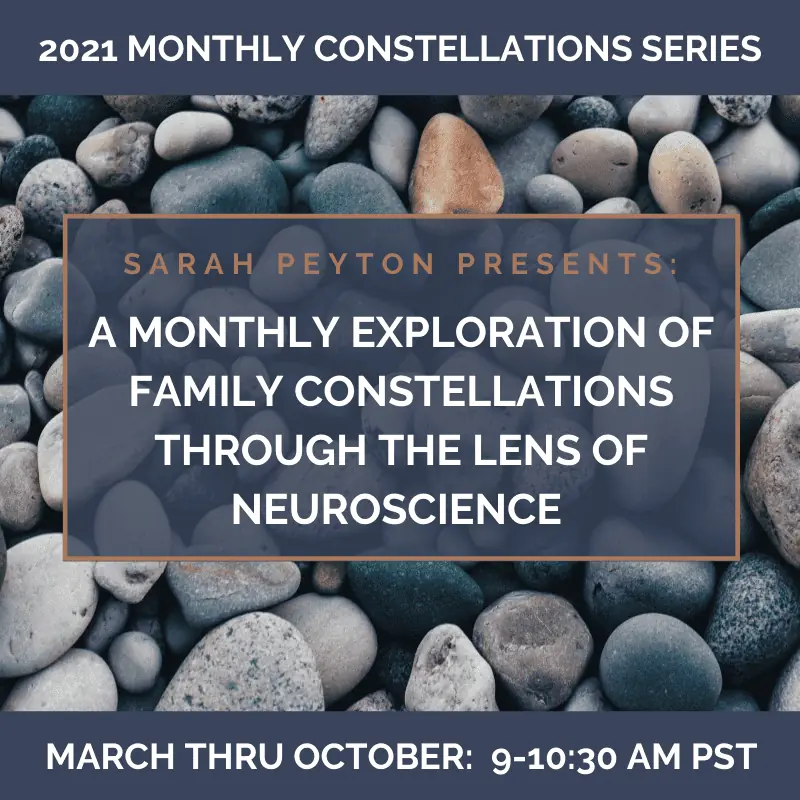Description
This is an all-in-one bundle that includes access to all of Sarah’s monthly Constellations and Neuroscience explorations from March 2021-October 2021.
By purchasing this package, you receive the full set of 8 pre-recorded webinars at a discounted rate.
The series includes the following topics:
- Brain Hemispheres and Facilitators: What It Helps to Know: Like all beings with vertebrae on this planet, humans have two hemispheres, one for keeping track of the big picture, and one for looking at details. This gives us two lenses for looking at the world. And this gives our clients two lenses through which they can see themselves and their lives. The healing that comes with constellation work shifts people into the big picture, but the big picture part of the brain is also where the hell of trauma comes alive. How do we provide the accompaniment needed to support client well-being?
- Warmth in Constellation Facilitation: Benefits and Clarifications: What does warmth mean to human brains? How does it nourish them? Is it important for constellation facilitators to have warmth for their clients? What are the implications for neutrality? These answers are different for every facilitator, yet a basic understanding of warmth for humans can help us determine our own balance points. What will an understanding of warmth do for your facilitation?
- Archetypes and Power in Brains and in Constellations: Two important resources for human brains are models for how to be and the naming of overarching human patterns. When we see archetypes represented in constellations, we feel a shift into our big picture vision, and we are invited to partake of both of these resources. Once we understand the mechanism of the shift, we become more comfortable asking for representation of archetypes in our constellation work. What archetypes are waiting to enter your constellations and support you and your clients?
- Attachment Patterns in Constellations: Identification and Movement: Social animals, including humans, have 4 main tendencies in the way they bond with others. They have an easy time coming and going, they have a visibly hard time with separation, they have a visibly hard time with reunion, and they are utterly unpredictable with outbursts of emotional or physical violence or of dissociation. How do we identify our clients patterns or the patterns in their constellations in ways which help us do the work we want to do for them?
- Avoidant Clients: Constellation Tools and Resources: What are the characteristics of clients whose parents have not been emotionally close to them? What happens to us as facilitators when we have such clients? What are the unconscious contracts of avoidant attachment? What are good movements to support brain healing and change in such constellations
- Ambivalent Clients: Constellation Tools and Resources: What are the characteristics of clients whose parents have been emotionally intrusive? How does the need for precision come into play? What happens to us as facilitators when we have such clients? What are the unconscious contracts of ambivalent attachment? What are good movements to support brain healing and change in such constellations?
- Disorganized and Traumatic Attachment: Constellating Movement: What are the characteristics of clients whose parents have been unpredictable, cruel, dissociated, terrified or terrifying? What happens to us as facilitators when we have such clients? What are the unconscious contracts of disorganized attachment? What are good movements to support brain healing and change in such constellations?
- Brain Growth in Clients: Tracking Healing and the Growth of Earned Secure Attachment: The delight of working in constellations with clients over time is seeing the growth of what is called “Earned Secure Attachment” – the way that brains grow into resilience and well-being in their relationships. What are the signposts that let us know that our clients’ brains are healing and that trauma is resolving? Knowing the path that brains travel to heal helps us see the pathways unfolding before us.




